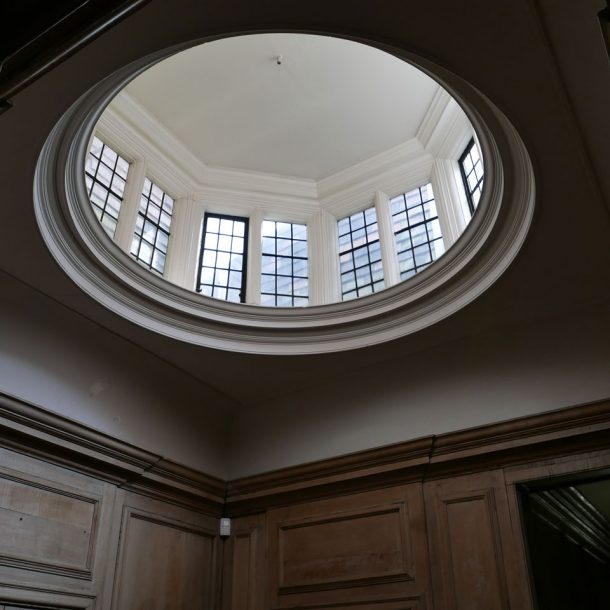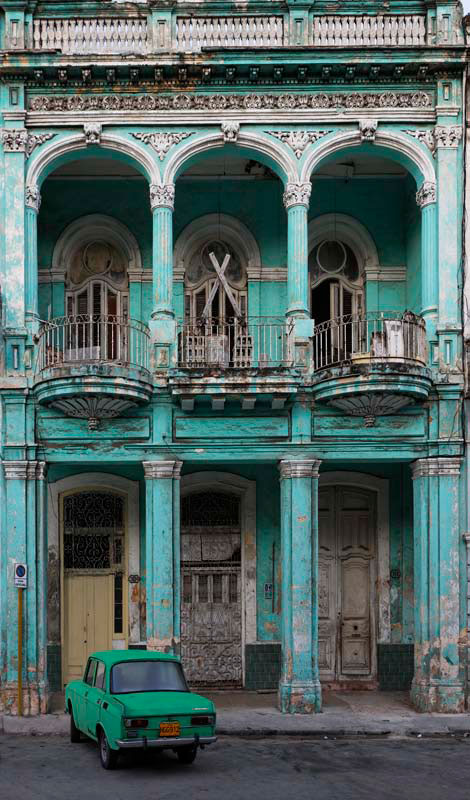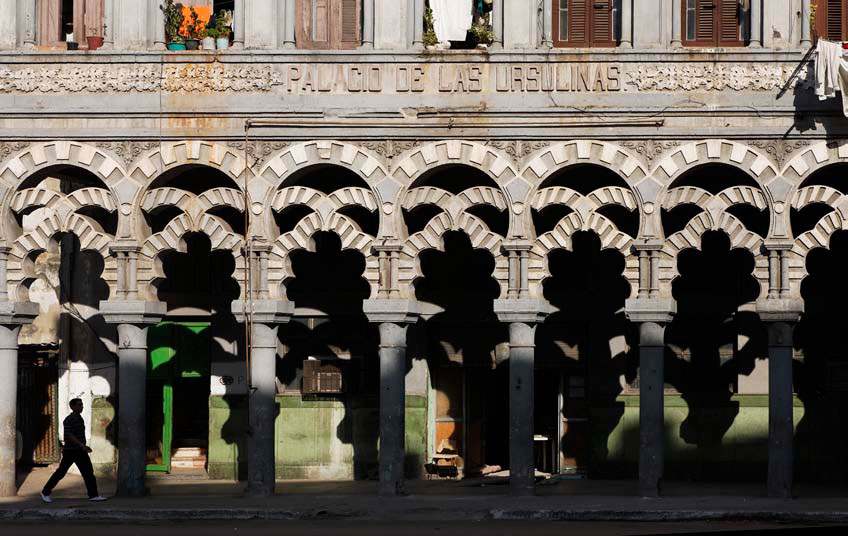
Recent Posts
- Venice 2023July 25, 2023
- Paris 2019October 18, 2019
- Moffly Media’s athome magazine A-List Awards 2019September 13, 2019
- Venice 2023
Archives
Categories
 We’re so used to seeing Beaux-Arts cities over-preserved as tourist centers, surrounded by modern suburbs, freeways, redevelopment, and here we have a vast neighborhoods—colonial, Beaux-Arts, Moderne, Deco—block after block—crumbling away in the salt air…no gentrification, no (late) twentieth-century overlay, like some Mayan civilization, inexplicably abandoned…
Of course, we all know bits and pieces of the social and political history, but I hadn’t expected the other-worldly physical effect of the built environment “on the ground”…block after block after block in Havana Viejo, full of quintessentially Spanish courtyard houses—some quite ancient, many nineteenth century—every last one abandoned by the oligarchy (thinking their flight to Florida was only temporary), now each one occupied by as many families as there are rooms: 12, 18, 24, each courtyard like the Moscow mansion in Dr. Zhivago, after the revolution (minus the snow, of course)…where tall-enough ceilings permit (every piano nobile) intermediate floors have been inserted with impossibly flimsy found materials, little ships-ladder stairs, little private water tanks high up in hallway ceilings, from old 55-gallon drums…oblivious children playing pick-up soccer games in the ruins of ball-rooms…magical and appalling all at the same time…
We’re so used to seeing Beaux-Arts cities over-preserved as tourist centers, surrounded by modern suburbs, freeways, redevelopment, and here we have a vast neighborhoods—colonial, Beaux-Arts, Moderne, Deco—block after block—crumbling away in the salt air…no gentrification, no (late) twentieth-century overlay, like some Mayan civilization, inexplicably abandoned…
Of course, we all know bits and pieces of the social and political history, but I hadn’t expected the other-worldly physical effect of the built environment “on the ground”…block after block after block in Havana Viejo, full of quintessentially Spanish courtyard houses—some quite ancient, many nineteenth century—every last one abandoned by the oligarchy (thinking their flight to Florida was only temporary), now each one occupied by as many families as there are rooms: 12, 18, 24, each courtyard like the Moscow mansion in Dr. Zhivago, after the revolution (minus the snow, of course)…where tall-enough ceilings permit (every piano nobile) intermediate floors have been inserted with impossibly flimsy found materials, little ships-ladder stairs, little private water tanks high up in hallway ceilings, from old 55-gallon drums…oblivious children playing pick-up soccer games in the ruins of ball-rooms…magical and appalling all at the same time…
 And, crumbling around our ears; they tell me there are about 3 “derrumbles” a day (as a statistical average) in greater Havana: 3 buildings a day collapse…they didn’t say about loss of life, but you see the empty sites, here and there from block to block (rubble carted away by unseen authority); sometimes half a building (to one side of a central stair-hall, perhaps) will have caved-in on itself—parts of the façade still standing—while the other half remains fully occupied (with no sign of stabilizing shoring)…a kind of architectural existentialism…
And, crumbling around our ears; they tell me there are about 3 “derrumbles” a day (as a statistical average) in greater Havana: 3 buildings a day collapse…they didn’t say about loss of life, but you see the empty sites, here and there from block to block (rubble carted away by unseen authority); sometimes half a building (to one side of a central stair-hall, perhaps) will have caved-in on itself—parts of the façade still standing—while the other half remains fully occupied (with no sign of stabilizing shoring)…a kind of architectural existentialism…
 I’m told the early 20th century buildings are particularly susceptible, as they used re-bar and concrete—not terribly good quality of either—and the salt air corrodes the re-bar from the inside, spalling-out chunks of concrete—increased rapidity of rust: no way to remediate or stabilize—so the Moderne and Deco structures are going first, the old coral-stone masonry holding up much better…like the paper/scissors/rock game, who’d have thought slow, dim-witted coral would out-perform steel…
Sitting in a doorway in the old city, looking up at a wonderful infill building, a dozen stories high, town-house narrow, its neighbor on one side vanished, great, jagged cracks running down one side of the façade, side-wall teetering out at some impossible angle (I’m afraid to walk over and look up more closely)…people walking up and down the street, no sense of the inevitable about to happen, a wonderful, quirky pre-war building (pre Great War), totally deserves to be preserved…
But for whom? No middle class (no aspirational middle class, in any case), no business or professional needs, no urban occupations to support millions of people (and this was, and is, a city of millions), very little tourism (and who wants to turn this place into Venice or Florence anyway, with everything above the street level empty, or occupied by mysterious, half-absent, parasitic bureaucracy…very tragic, like those seventeenth-century illustrations of Rome before the re-discovery of classical antiquity: shepherds herding livestock around the half-buried, weed-enveloped ruins of the Forum…
No shepherds or livestock here, of course, but I feel l strange, unexpected kinship with those eighteenth-century English tourists in Italy…
I’m told the early 20th century buildings are particularly susceptible, as they used re-bar and concrete—not terribly good quality of either—and the salt air corrodes the re-bar from the inside, spalling-out chunks of concrete—increased rapidity of rust: no way to remediate or stabilize—so the Moderne and Deco structures are going first, the old coral-stone masonry holding up much better…like the paper/scissors/rock game, who’d have thought slow, dim-witted coral would out-perform steel…
Sitting in a doorway in the old city, looking up at a wonderful infill building, a dozen stories high, town-house narrow, its neighbor on one side vanished, great, jagged cracks running down one side of the façade, side-wall teetering out at some impossible angle (I’m afraid to walk over and look up more closely)…people walking up and down the street, no sense of the inevitable about to happen, a wonderful, quirky pre-war building (pre Great War), totally deserves to be preserved…
But for whom? No middle class (no aspirational middle class, in any case), no business or professional needs, no urban occupations to support millions of people (and this was, and is, a city of millions), very little tourism (and who wants to turn this place into Venice or Florence anyway, with everything above the street level empty, or occupied by mysterious, half-absent, parasitic bureaucracy…very tragic, like those seventeenth-century illustrations of Rome before the re-discovery of classical antiquity: shepherds herding livestock around the half-buried, weed-enveloped ruins of the Forum…
No shepherds or livestock here, of course, but I feel l strange, unexpected kinship with those eighteenth-century English tourists in Italy…
 More wonders to come: in an outer suburb, what was once the most exclusive colonial/imperialist golf course, given over to a huge tribe of wide-eyed revolutionaries, to create this Arcosanti-like campus of amorphous, hand-built 60’s modernist buildings—then, later, abandoned as politically incorrect in the context of Soviet modular housing warehouses—now moldering-away…Martian archeologists would feel like this, wandering about in the ancient ruins of Brasilia…
More wonders to come: in an outer suburb, what was once the most exclusive colonial/imperialist golf course, given over to a huge tribe of wide-eyed revolutionaries, to create this Arcosanti-like campus of amorphous, hand-built 60’s modernist buildings—then, later, abandoned as politically incorrect in the context of Soviet modular housing warehouses—now moldering-away…Martian archeologists would feel like this, wandering about in the ancient ruins of Brasilia…
 Back in the old city, there’ some evidence of European development—tourist hotels and the like—from countries not too scared-off by American disapproval—Spanish, mostly—but these are embarrassingly tasteless and shoddy—(apparently) second-tier, 3rd-world-type efforts at capitalism…worse than nothing at all, if you ask me.
It almost seems as if Cuba is this strange collection of amazingly good luck combined with amazingly bad luck: you look at some other countries for perspective, and you have to think they escaped the unspeakable horrors of Guatemala, the sad, imperialist, corrupting influence of strategic partnerships with dictators and other very bad men—look how close they came to Las Vegas under Battista—only to suffer as collateral damage when the Soviet block turned out to be a house of cards. I have to think various U.S. administrations had plans to repossess the place for corporate interests—lord knows they did plenty of that all over the rest of the hemisphere and southeast Asia—but some quirks of fate kept putting off what everyone assumed was inevitable, and so left this island to their socialist health-care and trying to educate (almost)an entire nation of illiterate ex-slave plantation workers…Venezuelan oil money propped them up for a while, but Chavez’ death (and world recession) have plunged them back into the 3rd-world poverty they had a taste of when eastern European countries stopped buying their (subsidized) sugar…after so many years of this, so many of the delights one would expect to find—Carribean food, a vibrant palette of colors, restaurants, cafes and culture—have been lost to grinding poverty, no fresh staples and the like…very sad, but one hopes a little “spring rain” will bring green shoots up after all…
Back in the old city, there’ some evidence of European development—tourist hotels and the like—from countries not too scared-off by American disapproval—Spanish, mostly—but these are embarrassingly tasteless and shoddy—(apparently) second-tier, 3rd-world-type efforts at capitalism…worse than nothing at all, if you ask me.
It almost seems as if Cuba is this strange collection of amazingly good luck combined with amazingly bad luck: you look at some other countries for perspective, and you have to think they escaped the unspeakable horrors of Guatemala, the sad, imperialist, corrupting influence of strategic partnerships with dictators and other very bad men—look how close they came to Las Vegas under Battista—only to suffer as collateral damage when the Soviet block turned out to be a house of cards. I have to think various U.S. administrations had plans to repossess the place for corporate interests—lord knows they did plenty of that all over the rest of the hemisphere and southeast Asia—but some quirks of fate kept putting off what everyone assumed was inevitable, and so left this island to their socialist health-care and trying to educate (almost)an entire nation of illiterate ex-slave plantation workers…Venezuelan oil money propped them up for a while, but Chavez’ death (and world recession) have plunged them back into the 3rd-world poverty they had a taste of when eastern European countries stopped buying their (subsidized) sugar…after so many years of this, so many of the delights one would expect to find—Carribean food, a vibrant palette of colors, restaurants, cafes and culture—have been lost to grinding poverty, no fresh staples and the like…very sad, but one hopes a little “spring rain” will bring green shoots up after all…
 All Photos Taken By Victoria Montoro Zamorano –
For More Information
All Photos Taken By Victoria Montoro Zamorano –
For More Information